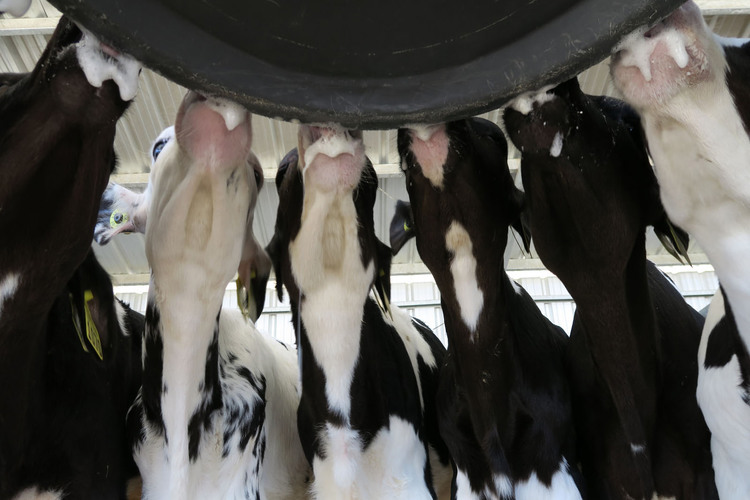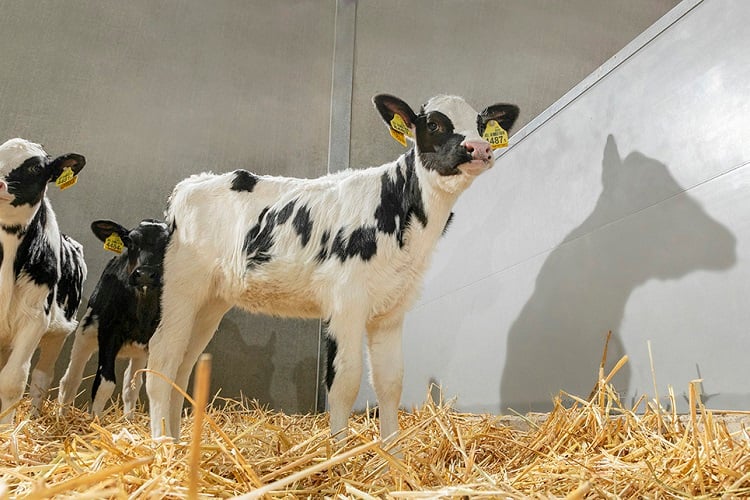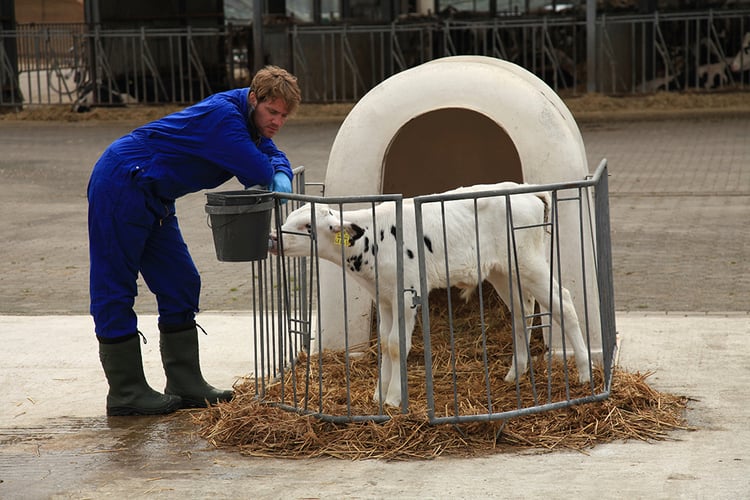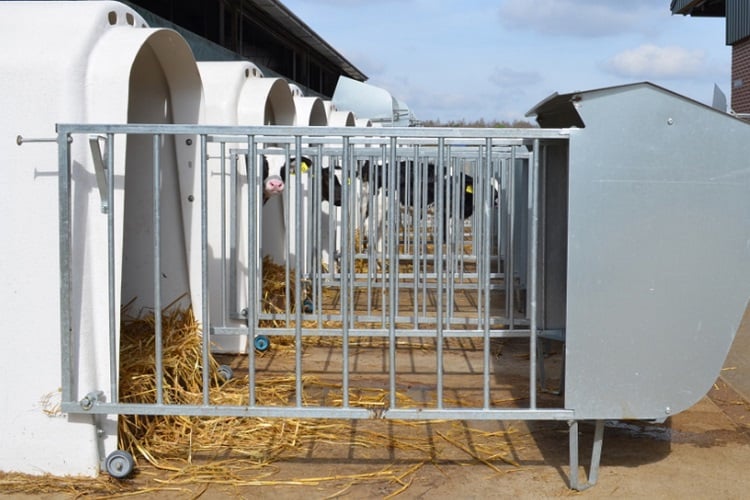- LifeStart
- Preweaning
Key takeaways from the research
-
Intensified calf feeding programs enable calves to double nutrient intake compared to restricted feeding programs.
-
Intensified calf feeding programs support greater rates of growth compared to restricted feeding programs.
-
Greater rates of pre-weaning gain have been associated with earlier calving ages and improved milk production.
-
Careful attention must be paid to weaning strategies for calves in intensified feeding systems.
-
Social housing can be beneficial in intensified feeding systems as it both encourages greater solid feed intake and reduces stress.

Intensified pre-weaning calf feeding programs impact behavior, growth and on-farm management
While the traditional approach to rearing dairy calves has focused on restricting the amount of milk or milk replacer as a means to stimulate early solid feed intake, dairy farms are increasingly adopting calf feeding schedules with higher planes of nutrition to stimulate growth. These intensified feeding programs allow for quantities of milk that is more closely aligned with levels that a suckling calf would consume in nature. Thus, whereas the conventional milk feeding rate of approximately 10% of a calf's birth weight would support just under 500 g/d of weight gain[1], these intensified plans have been shown to produce weight gains between 750 g and 1000 g per day.[2] These programs have short- and long-term benefits for both the growth and behaviour of dairy calves and implications for calf management with this newer approach to feeding. Dr Miller-Cushon of the University of Florida explored these issues in her literature review, "Intensified Pre-Weaning Calf Feeding Programs: Impacts on Growth and Behavior."[3]
Improvement of growth and welfare in early life
When calves are provided milk ad libitum, they consume between 8L and 16L per day.[4,5] Intensified calf feeding programs double the amount of dry matter fed on a bodyweight basis from 1-1.5% to 2-3%. These programs, therefore, have a great impact on early life calf performance, structural growth (both girth and height) and efficiency of feed conversion.[6]
Intensified feeding programs also show great advantages in terms of early life calf welfare. These feeding systems, especially when provided on an ad libitum basis, allow calves to feed closer to the way they would in nature, by consuming 8 to 10 meals per day (instead of the conventional, restricted practice of two meals per day) and thus spending a greater amount of time feeding (45 to 60 minutes per day feeding, compared to about 10 minutes per day feeding via the conventional method).[7] Those on restrictive programs, by comparison, exhibit greater signs of hunger (non-nutritive sucking and frequent unrewarded visits to the feeder). Intensified feeding systems thus have quite clear implications for calf welfare in terms of reducing hunger and restoring natural feeding behavior patterns, when feed is provided ad libitum.
Long-term production benefits of intensified calf feeding schedules
In order for these intensified calf feeding programs to make economic sense for dairy farmers, there must be increased long-term performance. Indeed, elevating the early plane of nutrition has been shown to increase long-term production potential. Research on the quantity and quality of milk replacer has shown reductions in age at first calving[8] and an increase in milk production. One such study by Soberon et al. (2012)[9] showed the positive correlation between pre-weaning average daily gain and milk yield in 1st lactation. For every 1 kg of pre-weaning average daily gain, there was an improvement in milk yield of between 850 and 1,113 kg. Thus, the increased costs of intensified calf feeding programs can be recouped by the 1st lactation.
Managing intensely fed calves
Implementing these intensified feeding programs requires certain on-farm management techniques for weaning and housing. As rumen development is slightly delayed with more intense milk feeding programs, it can be a challenge to support consistent growth through weaning. Therefore, post-weaning performance depends on a successful transition at weaning which can be achieved by weaning later[10] and gradually, via a step-down method.[11]
Additionally, intensified feeding systems generally utilize group housing, whereas in conventional feeding systems neonatal calves are typically housed individually. Calves housed in groups usually consume more solid feed prior to weaning.[12] and social housing also tends to reduce stress[13] and results in a more consistent weight gain through weaning.[14]
Ultimately, the short- and long-term benefits of intensified feeding systems include greater rates of growth, more natural feeding behaviour and the potential for an earlier calving age and increased production. A sound understanding of management techniques that must be implemented in order for intensified feeding systems to be successful is however crucial.
References
[1] Appleby, M. 2001. Performance and feeding behaviour of calves on ad libitum milk from artificial teats. Appl. Anim. Behav. Sci. 74:191–201. Jasper, J., and D. M. Weary. 2002. Effects of ad libitum milk intake on dairy calves. J. Dairy Sci. 85:3054–3058.
[2] Tedeschi, L. O., and D. G. Fox. 2009. Predicting milk and forage intake of nursing calves. J. Anim. Sci. 87:3380–3391. Appleby, M. 2001. Op cit.
[3] Miller-Cushon, E.K. Intensified Pre-Weaning Calf Feeding Programs: Impacts on Growth and Behavior. Florida Ruminant Nutrition Symposium, 2015.
[4] Appleby, M. 2001. Op cit., Jasper, J. and D.M. Weary. 2002. Op cit. Miller-Cushon, E. K., R. Bergeron, K. E. Leslie, and T. J. Devries. 2013a. Effect of milk feeding level on development of feeding behavior in dairy calves. J. Dairy Sci. 96:551–564.
[5] Khan, M. A., D. M. Weary, and M. A. G. von Keyserlingk. 2011a. Invited review: effects of milk ration on solid feed intake, weaning, and performance in dairy heifers. J. Dairy Sci. 94:1071–1081.
[6] Diaz, M. C., M. E. Van Amburgh, J. M. Smith, J. M. Kelsey, and E. L. Hutten. 2001. Composition of growth of Holstein calves fed milk replacer from birth to 105- kilogram body weight. J. Dairy Sci. 84:830–42. Khan, M. A., H. J. Lee, W. S. Lee, H. S. Kim, S. B. Kim, K. S. Ki, J. K. Ha, H. G. Lee, and Y. J. Choi. 2007. Pre- and postweaning performance of holstein female calves fed milk through step-down and conventional methods. J. Dairy Sci. 90:876–885.
[7] Appleby, M. 2001. Op cit. Miller-Cushon et al., 2013a. Op cit.
[8] Raeth-Knight, M., H. Chester-Jones, S. Hayes, J. Linn, R. Larson, D. Ziegler, and B. Ziegler. 2009. Impact of conventional or intensive milk replacer programs on Holstein heifer performance through six months of age and during first lactation. J. Dairy Sci. 92:799–809. Davis Rincker, L. E., M. J. VandeHaar, C. A. Wolf, J. S. Liesman, L. T. Chapin, and M. S. Weber Nielsen. 2011. Effect of intensified feeding of heifer calves on growth, pubertal age, calving age, milk yield, and economics. J. Dairy Sci. 94:3554–3567.
[9] Soberon, F., E. Raffrenato, R. W. Everett, and M. E. Van Amburgh. 2012. Preweaning milk replacer intake and effects on long-term productivity of dairy calves. J. Dairy Sci. 95:783-793.
[10] DePassillé, A. M., T. F. Borderas, and J. Rushen. 2011. Weaning age of calves fed a high milk allowance by automated feeders: effects on feed, water, and energy intake, behavioral signs of hunger, and weight gains. J. Dairy Sci. 94:1401–1408. [11] Khan et al., 2007. Op cit.
[12] De Paula Vieira, A., M. A. G. von Keyserlingk, and D. M. Weary. 2010. Effects of pair versus single housing on performance and behavior of dairy calves before and after weaning from milk. J. Dairy Sci. 93:3079–3085.
[13] De Paula Vieira, et al., 2010. Op cit.
[14] Chua, B., E. Coenen, J. van Delen, and D. M. Weary. 2002. Effects of pair versus individual housing on the behavior and performance of dairy calves. J. Dairy Sci. 85:360–364.



